CSA Week 12 Newsletter (Sept 3-10, 2022)
CSA Newsletter Week 12
Sept 3-10, 2022 | “B” Week
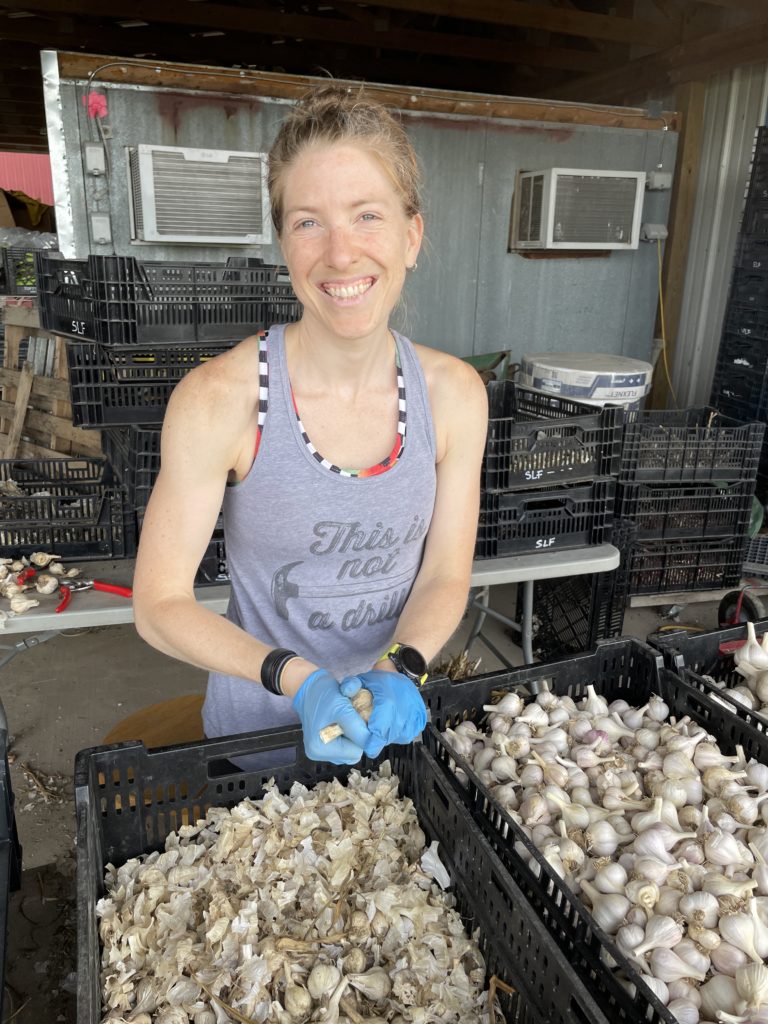
Clara Eckel cleans the final crate of garlic to end the Garlic Cleaning Challenge.
What’s in the Box this Week?
GOLD AND CANDY STRIPE BEETS (no tops) ~ Store the beet roots, with the rootlets (or “tails”) attached, unwashed, in a plastic bag in the crisper bin of your refrigerator. They will keep for several weeks. To prep: Just before cooking, scrub beets well and remove any scraggly leaves and rootlets. If your recipe calls for raw beets, peel them with a knife or a veggie peeler, then grate or cut them according to the recipe. To remove the skins, you can roast them in foil or boil them, and the peels will slip right off. To freeze: Boil or bake beets until done. Cool them in ice water or let them come to room temperature. Remove peels. Trim the beets into 1/4 inch slices or keep them whole (if they are small). Place in Ziplock freezer bag and remove as much air as possible. Seal and freeze.
RED RADISHES (1 bunch) ~ Remove radish leaves if they are still attached. Store the unwashed greens in a loosely wrapped plastic bag in the crisper bin of your refrigerator. Store radish roots unwashed in a plastic bag in the refrigerator for 1 week. To prep: Scrub radishes well. Trim off the stem and rootlets. To use: Eat radishes raw with a sprinkle of salt. Grate radishes into slaws and salads. Try small young radish leaves in salads or scrambled eggs. Blanch whole radishes in boiling, salt water for 5-10 minutes, or steam them until just tender, 8-12 minutes. Top with butter, salt, and pepper or with a vinaigrette. They’re also great grilled and pickled. To freeze: Blanch for 3 minutes, then dunk in ice water for 3 minutes. Drain. Pop in a freezer bag and freeze. The radish greens can be blanched as well — but only for 2 minutes.
GLOBE & HEIRLOOM TOMATOES (3) ~ You will receive one heirloom and 2 globe tomatoes at least. Heirloom tomatoes will have cracks and weird shapes to them. To store: Do not refrigerate tomatoes. Store them at room temperature out of the sun stem side down. Putting them in a paper bag will accelerate the ripening process. Heirloom tomatoes will have strange shapes and cracks. They should be eaten on the first or second day, as they have a very low shelf life — but incredible flavor!!
CHERRY TOMATOES (1 pint) ~ Store these at room temperature on your counter. Wash before eating. Eat them out of hand or try roasting them.
MIZPUNA 0.4 lb (salad greens) ~ Store unwashed lettuce in a plastic bag in the refrigerator. To store lettuce that you have already washed and dried with a spinner, place back in a plastic bag with a dry paper towel in the bag, and place the package in the vegetable crisper bin. Use within 4 days.
AMARANTH (salad greens) 1 bunch ~ Amaranth has a beautiful purple-red heart-shaped leaf and it tastes a little like spinach. Store unwashed amaranth in a plastic bag in the refrigerator. Use within 4 days.
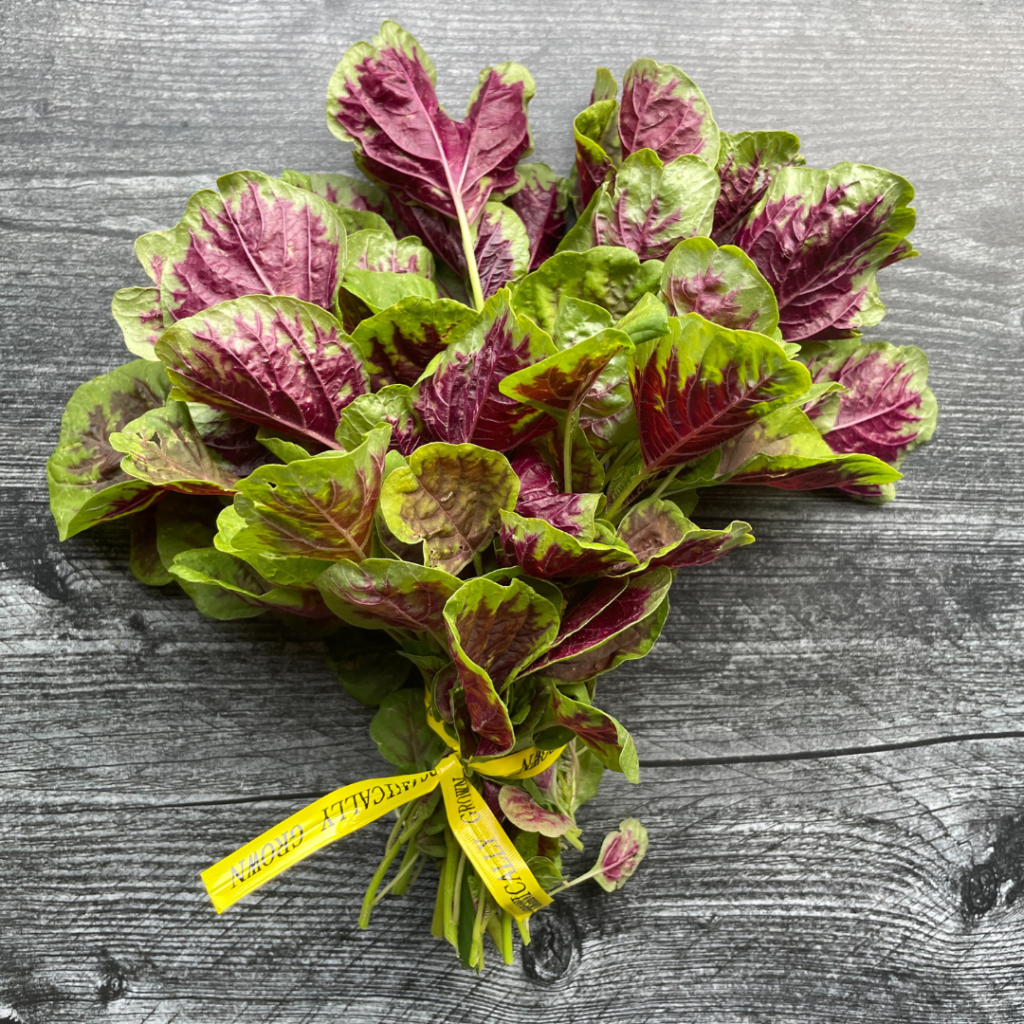
This is what amaranth looks like!
ORANGE/GREEN BELL PEPPERS (2) ~ To store: Refrigerate peppers unwashed in a sealed plastic bag in the crisper drawer for 1-2 weeks. To prep: Cut in half and remove the seeds from the inside. Slice, chop or mince. To freeze: Wash and dry peppers. Freeze whole or cut into bite-size pieces and place in Ziplock freezer bag, removing as much air as possible.
SNACK-SIZE MINI SWEET PEPPERS (1 pint) ~ these look like mini bell peppers. They are sweet and perfect for a lunchbox treat! Red and yellow color mix. Refrigerate peppers unwashed in a sealed plastic bag in the crisper drawer for 1-2 weeks.To freeze: Wash and dry peppers. Freeze whole or cut into bite-size pieces and place in Ziplock freezer bag, removing as much air as possible.
JALAPENOS (3) ~ Refrigerate peppers unwashed in a sealed plastic bag in the crisper drawer for 1-2 weeks. You can also dehydrate peppers for long-term. To prep: Be careful when preparing hot peppers of any kind. For greatest safety wear rubber gloves while chopping and handling them. Do not touch your eyes, nose, mouth or other places. Wash hands thoroughly when finished. Slice off the top of the hot pepper, including the stem. Since the heat in chili peppers is concentrated in the seeds and membranes, you can cut out the heat-filled seeds and membranes for a milder heat. To freeze: Wash and dry peppers. Keep whole, or cut into bite-size pieces and place in Ziplock freezer bag.
GARLIC (1) ~ Like onions, garlic can be eaten fresh or dried. Dried, cured garlic appears in August and can be kept for several months in a dark, dry, well-ventilated place at a cool room temperature. Warm temperatures will encourage the cured garlic to sprout. To prep: Remove the papery skin and base. Mince or chop as needed. To cook: For garlic aroma, try rubbing a cut clove around the rim of a baking dish. Try roasting garlic: cut tops off garlic to expose cloves, brush with olive oil, and bake for 1 hour at 350 degrees. Squeeze garlic out of its skins and spread on crusty bread. To freeze: Leave the skins on and place individual cloves in a Ziplock bag or Mason jar; then freeze.
SWEET CORN (6) (not organic, non-GMO) ~ To store: Refrigerate sweet corn as soon as possible with husks on. The longer you wait to eat it, the more sugar will turn into starch, and the corn will lose its \ sweetness. To prep: You can eat corn raw or cook it in the husks. Shuck the cob by pulling the husks down the ear and snapping off the stem. The silks will fall off as you cook the corn. Rinse under cold water. If you see a green worm, just cut out the damaged section — the rest of the cob is still edible! To cut the kernels off the cob, stand the cob upright on its base and run a sharp knife from the tip of the ear down to the base. To cook: Steam corn in 1-2 inches of water for 6-10 minutes, or drop ears into boiling water for 3-6 minutes. Season with butter or salt. You can also grill corn in the husk — place the corn in its husk in water for 10 minutes — then place on grill for 15 minutes. To freeze: Blanch on the cob for 3-5 minutes, rinse under cold water, and drain. Cut off the kernels with a knife, and then pack it into airtight freezer containers.
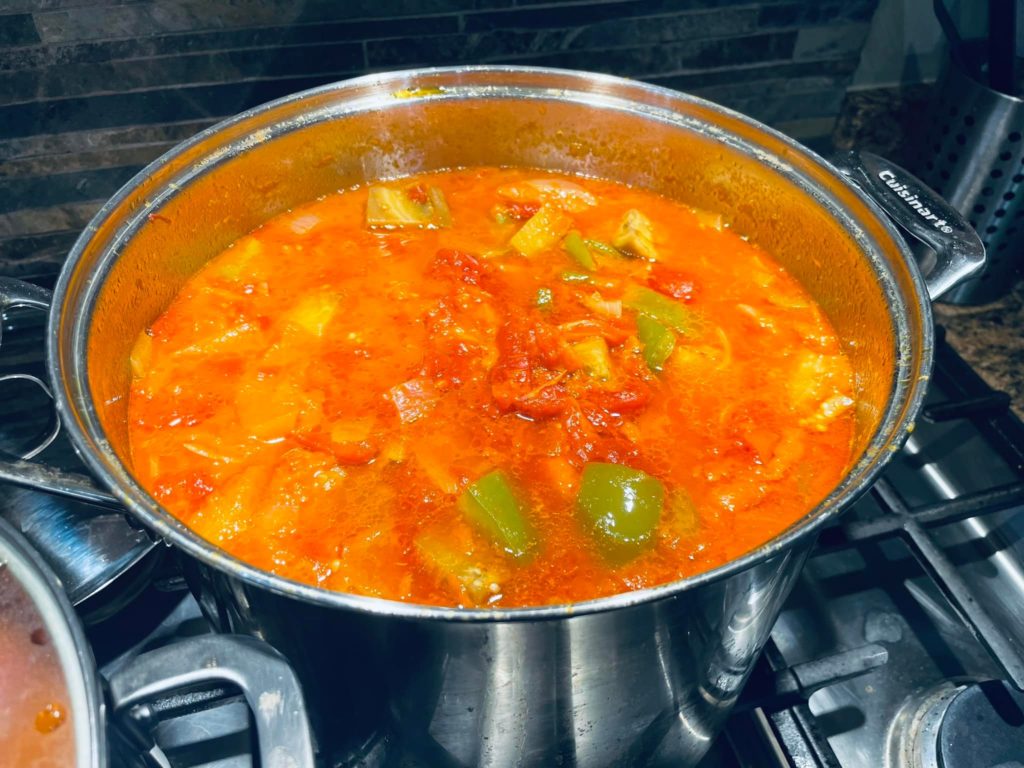
Kate Lynn made tomato sauce from orange romas this week, and canned them.
WEEK #12 ADD-ON SHARES: Week “B”
Odd-numbered weeks of our CSA season (week 1,3,5) are called “A” weeks. And even-numbered weeks (week 2,4,6) are called “B” weeks. If you have any kind of non-veggie, bi-weekly share, you have been assigned to either “A” or “B” week for the season. If you get a cheese share, it always comes on Week “A.”
WEEK 12 FRUIT SHARE:
Remember, the fruit share is a 16-week product. It will end on week 16 of our 18-week veggie CSA season.
HONEYCRISP APPLES (Quarry Hill Orchard) ~ Store apples in your refrigerator in a plastic bag. They are odor-absorbent, so keep them away from onions, potatoes, and other strong-flavored items. Apples can also be dehydrated (with cinnamon sprinkled on top), and stored in a Ziplock bag!
PLUMS (Quarry Hill Orchard) ~ If your plums are hard as a rock, that means they are still unripe. Store them out of the sunlight on the countertop until they are soft and aromatic. Once they are ripe, place them in a plastic bag in the fridge.
WATERMELON: (Bench Farms) : Refrigerate watermelon right away. They do not ripen off the vine or emanate a ripe smell. Cut melon should be covered in plastic wrap, and chunks or slices should be kept in an air-tight container. Eat melons within a week.
Ice Cream Flavor of the Week:
Maple Pecan from Knueven Creamery. Note: be sure to stop and pick up your ice cream from the Knueven milk truck at your pickup site! They will be located either right before or after your veggie pickup. Your farmers will not be passing this out in their delivery line.
Coffee Flavor of the Week:
Bella’s Breakfast Blend: Maddie & Bella Coffee Company
 CLEAN OUT THE FRIDGE CHALLENGE
CLEAN OUT THE FRIDGE CHALLENGE
Dates: Sept. 3-17, 2022
We’ve heard through the grapevine that some of you are drowning in veggies! Not to worry. This is COMPLETELY normal this time of the season. And we want to help you get over your food-waste-guilt and get back in control of that exploding fridge.
So we’re launching a 2 week “Clean Out the Fridge Challenge” where the goal is to (you guessed it) clean out your fridge of veggies by Sept. 17th. All those peppers and tomatoes and greens (and eggplant?) that you don’t know what to do with?… let’s use them up — either by creating freezer meals, freezer soup bags, freezer-ziplocs, and more. Every few days, Cadie and Corinna will be sharing quick ideas for how to clean out your fridge — tried and tested ways that CSA members use year after year. And yes, we have a prize for playing!
So how do you participate in the fun?
To enter to win the prize, you simply post 2 pictures of different ideas or strategies you’re implementing that week to get rid of veggie overload. Hashtag the posts with #cleanoutfridge22. These posts will inspire other members of our community to try it out. Look for EASY, FAST ideas. They can be repeat examples that others have already shared. The idea is to build momentum in the group as we all see each other trying to do one thing a week to stay ahead of our fridge monster.
I will choose 3 winners on Sept 18 from a hat who will win a $20 Amazon gift card!
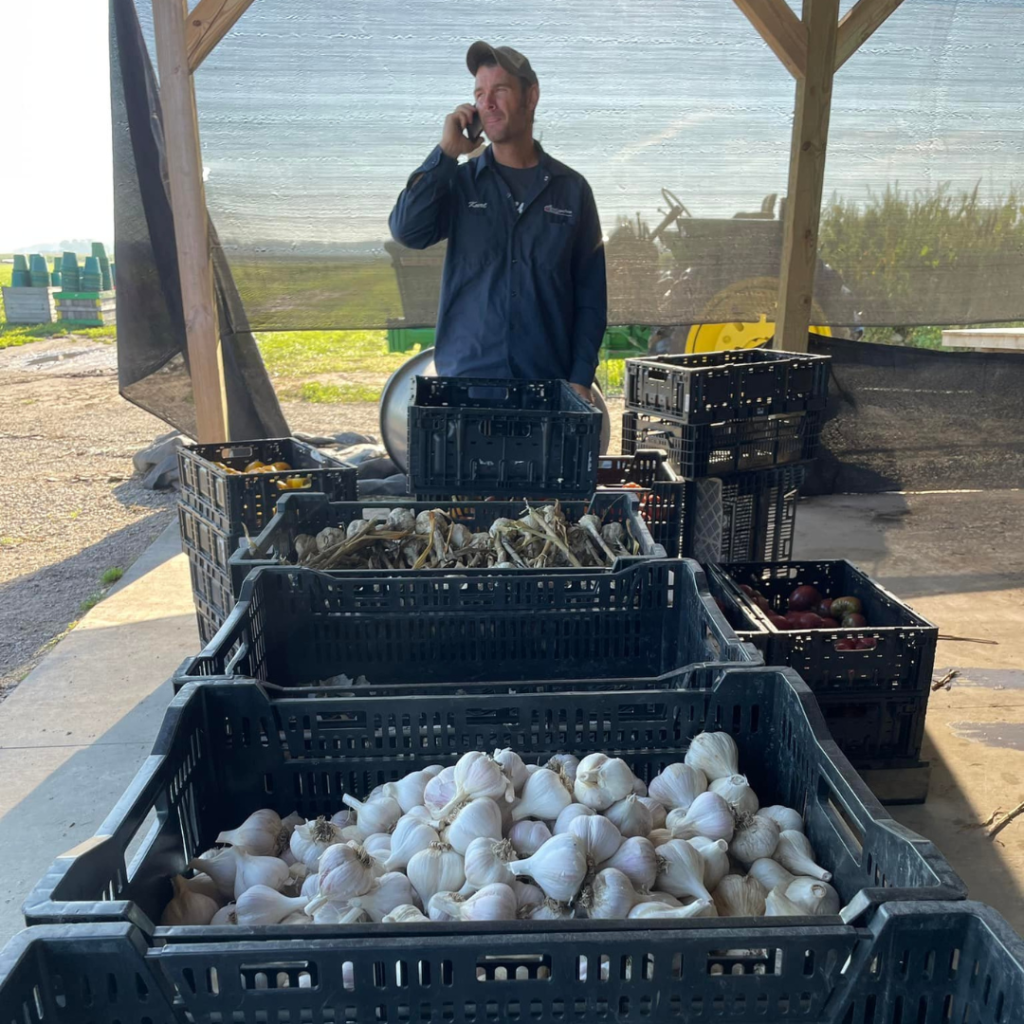
We processed 50 crates of garlic this week!
FARMER KURT’S FIELD NOTES
Happy Labor Day Weekend!
The Garlic Cleaning Challenge is over! And you guys showed up BIG TIME. My guys didn’t have to touch a single clove all week long. We saw 23 different volunteers come out this week to each take a leg of the Garlic Relay. Friday night, Clara Eckel took the final leg of the race and finished off the final 4 crates with Corinna. This is the time of year I order garlic seed. And before I do, I always like to take stock of my own garlic seed, since the garlic seed is the most expensive seed I buy. (Some of these bulbs will be cracked into cloves, which function as the seed). Having this job done by the weekend allows me to confidently place my garlic order for next year. So THANK YOU to everyone who showed up and spent and hour or two at the garlic station.
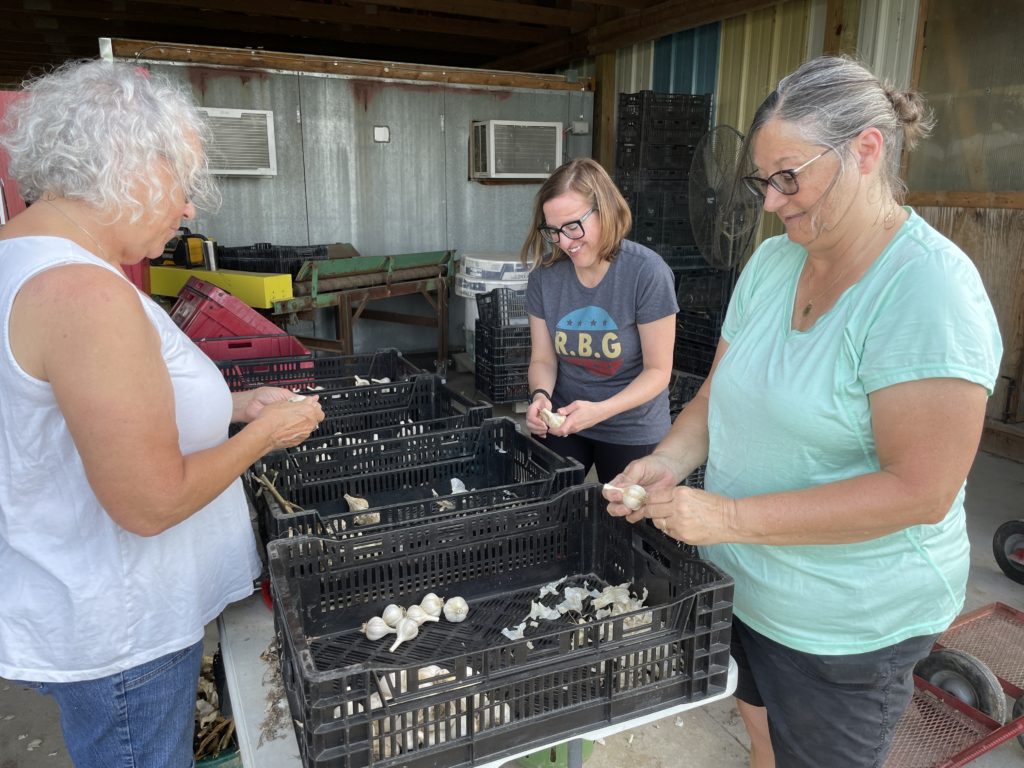
Pam McKinley, Mollie Hojnicki, and Gabby Beck were 2 of the 23 volunteers who showed up this week to process the garlic!
Josiah went back to public school this week. This is the first time he’s been back in 2 years. He was extremely excited to see some of his old friends and teachers. He’s still feeling it out, trying to get used to the schedule. (He gets lost in the building and is often still late to class). His favorite class is MATH!! How about that? He skipped a grade for math, and is now in 7th grade Pre-Algebra. He thinks it’s funny that he has to get a hall pass to go use the bathroom — little freedoms he took for granted at home.
Field work continues this week. We started pulling the poly off some of the beds. I also disked up a few beds to prepare for the fall. I pulled out the cultivator this week and weeded some of my fall veggies. Things are looking really good for our season close-out. The low tunnel that used to hold our cucumbers is now stripped bare. I took the plastic skin off the tunnel and am deciding what will go in there next. I’ve planted some cover crops into my garden beds by the house to replenish their juice. And I’ve pulled out the irrigation reel — we are done watering with it for the season.
My neighbor Josh came out to mow down the tall grass on the outskirts of our fields. He does this for me every few weeks. We have an arrangement that he does the mowing and baling, and he gets to feed the bales to his cows (plus I throw in some sweet corn from time to time). In this way, we scratch each other’s back. There are so many examples of this kind of bartering that happens out here between farmer-neighbors.

Pedro picks tomatoes. SO many tomatoes.
I have so many tomatoes. By the end of this week, we should have met all the tomato canning pre-orders. If you want anymore, I have plenty. In fact, I’ve stopped picking some of the plants. Next year, I’ll grow a few less beds! I sold a huge order of heirloom tomatoes to a wholesale supplier last week, and my mom’s roadside stand is taking a lot of them too.
This week, you’re trying a new crop I’m growing for the first time — amaranth. Let me know what you think. It’s supposed to taste like spinach. I think the leaf coloring is beautiful. I’m hoping to do this one again next year.
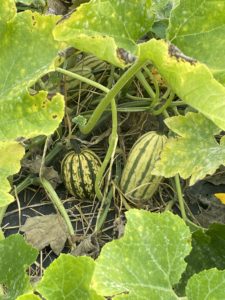
See the Delicata (winter) squash peeking through!!?
Our Farm to Table dinner is now sold out. I can’t wait to see all of you and celebrate our season on Sept. 10th (as it quickly comes to an end!!) We moved a big pile of fill dirt that was sitting in the dinner area. Usually I wait until the day before the dinner to start cleaning up that space, and I always pay for it! Feels good to be ahead of the game there.
Some of you are asking about next year already and how to sign up. Corinna will start talking about that in a few weeks, and you’ll be given an opportunity to renew your membership/share in the farm in October. This applies to full season AND Sampler members. I think the early bird deadline will be the last day of our CSA. (After that we sell the leftover spots to our wait list). Anyway, just stay tuned… Corinna will make sure you know about it. We are still working through our budget for next year, trying to anticipate what the market is going to do. With the reality of our rising labor and fuel costs from this season, I want to make you aware we’ll be raising our prices this year in order to stay profitable. I can’t believe how much everything has gone up. We locked in share prices last year during early registration (before the inflation hit), and it has taken a toll on our bottom line this year. I hate raising prices as much as the next person, but I also need to be able to pay my guys.
I can’t tell you enough how much I appreciate seeing all of you each week at the pickup sites. It really does recharge my batteries. All the little ways you let us know that you appreciate us — from happy smiles to pick-me-up music, to cold beer, popsicles, and gas cards. You’re all awesome. I’m the luckiest farmer there ever was.
I’m physically tired! Looking forward to a Labor Day break. This weekend, Corinna and I are taking the boys to my college buddy’s house in Bucyrus. We’re going to set up our giant tent in their yard and spend the night, so I can watch the Ohio State game in all my glory. A big shout out to my harvest and Monday pack crew, who are coming in on Labor Day morning to pack the CSA boxes for Tuesday.
~Your Farmer, Kurt

Terri Molter shared this roasted beet with pecans and goat cheese.
WEEK 12 ANNOUNCEMENTS
- Check out details above on our 14 Day “Clean out the Fridge Challenge” It’s our next contest/challenge activity, designed to inspire each other to get back in control of our overflowing fridge, and let go of the food-waste-guilt. We’re doling out a prize to one lucky winner at the end! Be sure to participate!
- You can now pre-order Canning tomatoes (25 lb) from the farm via email. To place your pre-order, email me. Tell me how many 25 lb. orders you want and what type (Roma or Globe), and what your pickup site is. I’ll send out an email a few days before your pickup to let you know they are coming. .Payment is expected at the time of pickup.You can choose from these two tomato canner products:
- ROMA TOMATOES — you’ll get 25 lbs of these classic, oval-shaped, paste tomatoes. These are best used for sauce and salsa, since they have a lower water content. Price: $30
- GLOBE TOMATOES – you’ll get 25 lbs. of the classic round tomato. These are best used for canning whole tomatoes. This will be enough to can 7-8 quarts (or 16 pints) in your canner. Price: $30
3. FIELD TO TABLE DINNER IS SOLD OUT!! We will be emailing instructions to you a few days before the event.
4. You can order additional items from the Shared Legacy Farms online store. Our store link is super easy to remember: www.sharedlegacyfarms.com/store. Just be sure to select the right pickup site that coincides with your pickup location. If the pickup option is greyed out or not available, it means you missed the window to order. You need to place your order 36 hours before your site. We harvest the product on Monday and Wednesday mornings — early. This week, the store will have: bulk canning tomatoes, sweet corn, bulk sweet corn, cutting celery herb, parsley, mixed mini bell peppers (pint), red and orange italian fry peppers (quart), jalapenos, red jalapenos, Jimmy Nardello peppers, shishitos, tomatillos, All-star kale, dino kale, ground cherries, eggplant (2 types), cherry tomatoes, Swiss chard, globe tomatoes, icebox watermelons, possibly plums (will be added later in the weekend), honey, local maple syrup.
8 Ways to Get Rid of All Your Tomatoes
And just like that, the tomatoes have taken over. Doesn’t it seem that two weeks ago, we were waiting with bated breath for the tomatoes to even start?
Every year I feel guilty that I didn’t take advantage of the tomatoes while they were here. Instead, I let myself get overwhelmed and just give up.
Then in the winter, when I’m eating cardboard tomatoes from the store, I am wishing I’d taken the time to store up that great summer taste.
Preserving tomatoes does take a little bit of time, but there are some short-cuts you can use, especially if you have lots of freezer space.
Here are 8 ways to store away those tomatoes.
 1.Can them whole.
1.Can them whole.
I like to can globe tomatoes, and use them in my pasta sauces and soups later in the year, but other CSA masters will use Romas or even heirlooms (although those will have a lot of water in the jar). Canning sometimes feels a little scary to newbies in the CSA. I get it. But I’ve created a terrific email training that will take away the fear factor and get you one step closer to trying your first batch.
To grab my Canning Equipment Checklist to get started, subscribe below.
You’ll be subscribed to an email drip campaign for a couple weeks, that will teach you what you need to know.
Get the Canning Equipment Checklist
Want to learn how to can, but feeling a bit intimidated? Where do you even start? Download our Canning Equipment Checklist. It includes a visual guide for everything a beginning canner will need to start preserving, including 6 of our easiest starter recipes. You'll also be subscribed to our emails which will slowly bring you confidence in taking the first step to canning mastery!
2. Slow-roast them.
This is a VERY popular exit strategy for our CSA masters. And again, the tomato variety doesn’t matter, although you’ll get the best results with Romas or cherry tomatoes.
Quick results: You can either roast them “hot and fast” at 400 F for 20-30 minutes, or “low and slow” at 300 F for 90 minutes. To do so, take the Romas or cherries, cut them length-wise in half and place them cut-side up in the non-reactive baking pan. (You can coat them in olive oil and salt first if you wish). Use the finished product for concentrated tomato flavor in marinara, pizza sauce, hummus, tomato pesto, or vinaigrettes. (You’ll have to run them through a food mill to remove the seeds and skins prior to use).
Overnight: If you want to “fix it and forget it” you can roast them overnight while you sleep. Set your oven at its lowest setting around 150-175 F before you go to bed and roast for about 8 hours until you get the desired level of dryness.
Store the dried tomatoes in a Ziploc bag and freeze/refrigerate, or place them in a quart-size Mason jar covered with this olive oil seasoning and refrigerate. (Use this recipe: 3 cups olive oil, 2 tablespoons Italian Seasoning, 1/4 t. garlic, 2 T. of balsamic vinegar, 2 t. lemon juice, 1 t. salt, freshly ground pepper to taste).
Watch our YouTube video here to see how to slow-roast.
3. Dehydrate them.
Once again, I would recommend this step for Romas, globes, or cherry tomatoes — not heirlooms! (Way too much water). Wash and core the tomatoes. Slice the tomatoes about ¼ inch thick and place on the dehydrator racks. No peeling. Then set the temperature at 155 degrees (or what ever your dehydrator instructions say) for about 5-8 hours (depends on the size of your tomatoes). It takes 4 lbs. of tomatoes to yield one quart of dehydrated tomatoes.
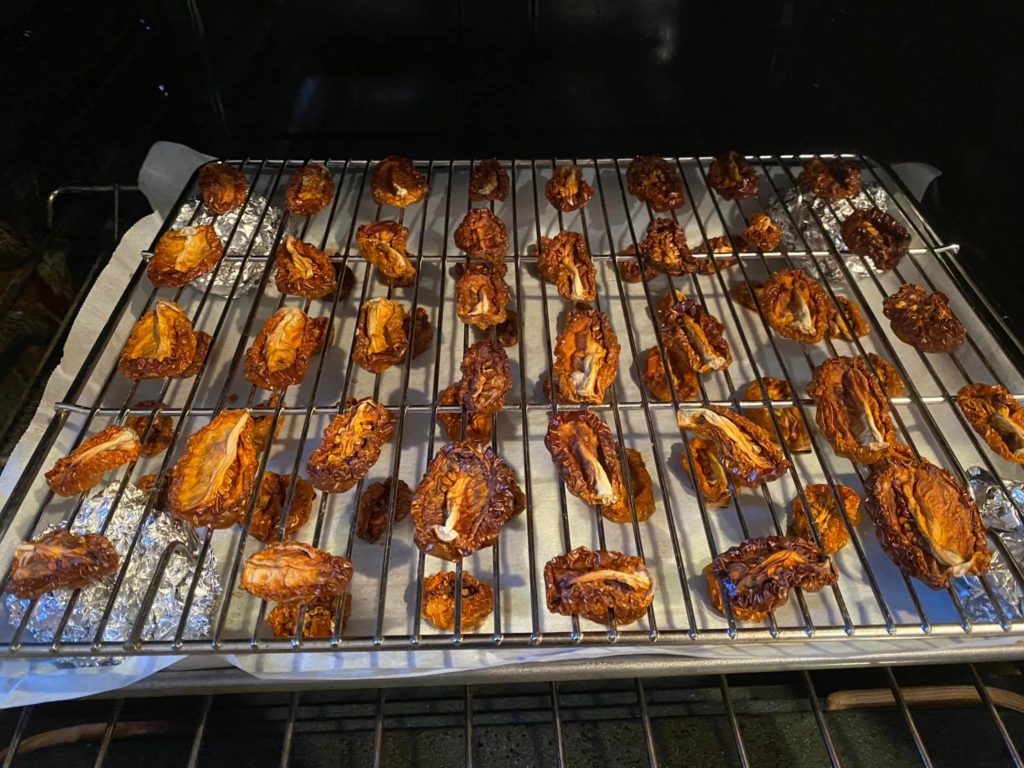
Merissa Rojas successfully roasted her golden romas in a low temperature oven.
4. Freeze them
So many people don’t realize you can freeze tomatoes super easily. Ideally, you want to remove the skins before you freeze, but you don’t have to! Frozen tomatoes are great for soups and sauces later in the year.
Non-Peeled: Flash freeze! Just bag your tomatoes in a freezer Ziplock and freeze! When you thaw them for later use in a soup or pasta dish, the skins will come right off. If you don’t take the time to thaw them first so you can de-skin them, they skins will come off in your dish (and you can either eat them or skim them out — a little annoying but hey, it works).
Peeled: If you want to skin the tomatoes first, place an “x” in the end of the tomato with a paring knife and drop the tomato into a pot of boiling water for 30 seconds. Remove and the skins will pull right off. Then freeze them whole in Ziplock, or cut them into chunks before you freeze.
Watch our YouTube Tutorial video showing 3 ways to peel a tomato.
Another fast way to peel tomatoes is to broil tomato halves in the oven for 3-4 minutes, skin-side up. The skins will shrivel up and remove some of the moisture.
You can also freeze the peeled tomato chunks in little mini muffin tin trays, then pop them out into a Ziplock bag. This is a great option if you want to control your portion sizes, and makes it easy to just pop in the right amount of tomatoes in recipes later on.
Watch our YouTube Video tutorial here on how to freeze tomatoes.
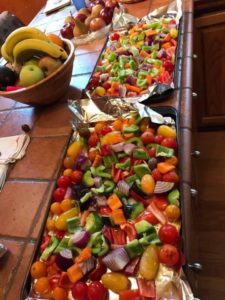
Karen Ayer’s Marinara Freezer Sauce is a legend in our group.
5. Make Marinara Sauce
Once you’ve roasted or frozen some of those tomatoes, you can pull them out of your Ziplock baggie, run them through a food mill (to remove the seeds and skins), and use them in a marinara sauce. (This will cut down the cooking time immensely). Or just whip out the frozen tomatoes as your base. You can then make large batches of marinara sauce and freeze it or can it! Here’s a good basic recipe.
Remember, if you want to can marinara, you should use a recipe that’s been kitchen tested — especially if it has other veggies in it! Those veggies alter the pH of the sauce, and may cause spoilage later on. Pressure canning is also highly recommended for marinaras that use other veggies.
6. Make Salsa
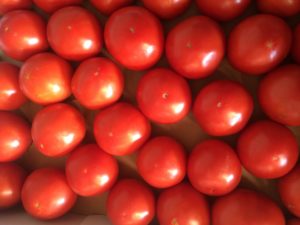
Globe tomatoes make really great canned tomatoes.
This is a great easy way to get rid of your tomatoes. There are countless salsa recipes online to experiment with, but the basics involve tomatoes, onions, garlic, cilantro, peppers or jalapeno, and lemon juice. Remember, if you want to can a salsa, be sure you use a kitchen-tested-approved recipe for safety.
To see my article on 9 Ways to Use Salsa, click here.
7. Tomato Purée
Puree can be used for making pasta or pizza sauce. If you don’t have time to make the sauce right away, you can just make the puree and then freeze it in Ziplock baggies (or ice cube trays) in your desired portion sizes. The best tomatoes for this purpose are Romas, as they have the least amount of water.
Coarsely chop tomatoes and simmer until the fruits begin to break down. Purée the tomatoes in a blender, or pass through a food mill if you’d like to remove seeds and skins. Return the purée to the stove and simmer it to your desired thickness. It can take many hours for the puree to cook down, so be ready! A longer-cooked, thicker puree with garlic, onions, and herbs added makes a great pasta or pizza sauce.
8. Make Tomato Juice
Follow the instructions for tomato puree, but use globe tomatoes or heirlooms for the best results and flavor. After passing the cooked tomatoes through the food mill, return the puree to the stove and simmer for a short time. Then refrigerate for immediate use or freeze/can for later use. Use in Bloody Marys or as a base for soups and chili. Here’s a good basic recipe for juice.
Basic Tomato Juice
Adapted from The Urban Farmer
Wash 5-20 pounds of ripe red tomatoes and then core and quarter them.
Use a large stainless steel pot so it doesn’t react to the acidity of the tomatoes. Place the tomatoes in the pot. For flavor add small halved red onion, one celery rib with leaves, lemon juice, and carrots for flavor.
Cover and cook over medium heat, stirring often. Cook for about 30 minutes until tomatoes are soft.
Discard the optional ingredients. Pass the tomatoes through a food mill. Discard the solids. Use the smaller holed-insert for your food mill.
Measure the juice. Rinse the pot. Return the juice to the pot. Add 1 teaspoon of sugar and up to 1 teaspoon of salt for each 4 cups of tomato juice. Add pepper to taste.
Stir as you bring the pot to a boil, and then reduce the heat to boil gently for 5 minutes.
Cool, then chill. If desired, you can pour the juice through a sieve to filter out any thick areas or seeds that may have passed through the food mill. May be refrigerated for up to three days.
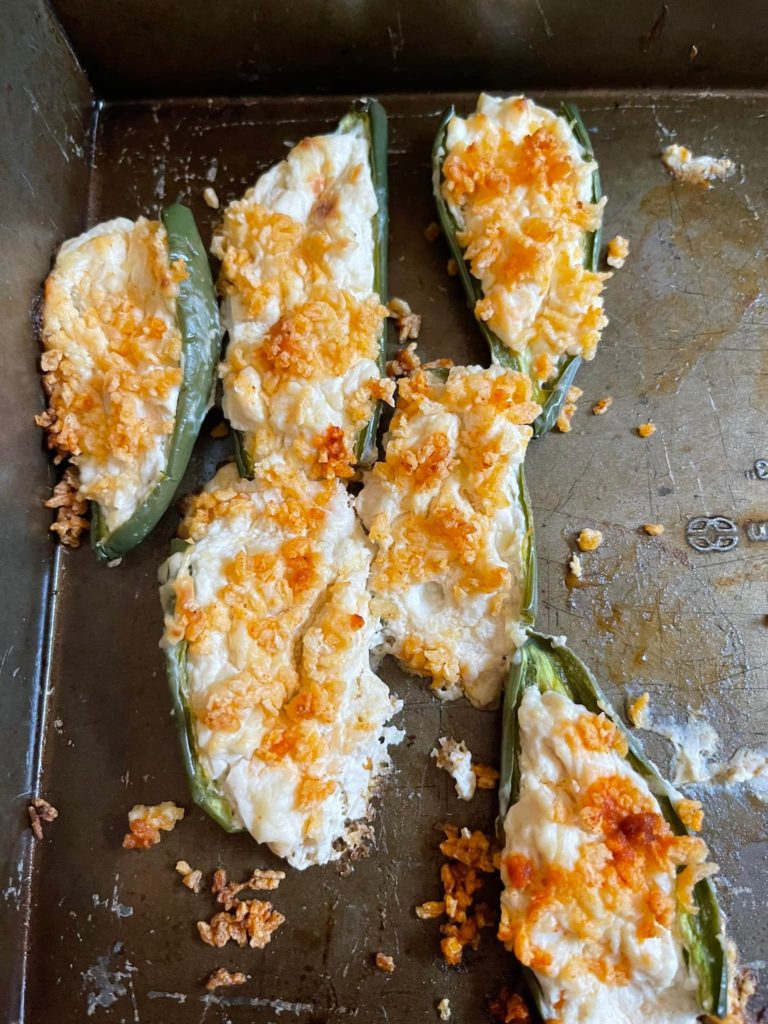
Stuffed jalapenos by Angie Patchett
WEEK 12 CSA RECIPES
Members: You can download these recipes as a PDF. These recipes are designed to inspire you to use your box this week! Please check inside our private Facebook group to find your fellow members sharing ideas for what to make with their box! Share a photo and you might be featured in next week’s newsletter!
Bell Pepper Tomato Salad
Garlic Roasted Cherry Tomatoes
Heirloom Tomato Concasse with Wilted Swiss Chard
Grilled Jalapeno Corn on the Cob
Big Beans and Tomato Vinaigrette
Garlic Roasted Radishes
Roasted Red Peppers and Cherry Tomatoes with Ricotta
Grated Beet Salad
Beetroot and Feta Salad
Dark Chocolate Beet Brownies
Sheet Pan Chipotle Cheddar Corn Enchiladas
Fresh Tomato Salsa
Amaranth Greens with Pork
Garlic Amaranth Greens
Carrot, Radish and Ginger Salad
Plum Salad with Black Pepper and Parmesan
Apple Spice Waffles

 CLEAN OUT THE FRIDGE CHALLENGE
CLEAN OUT THE FRIDGE CHALLENGE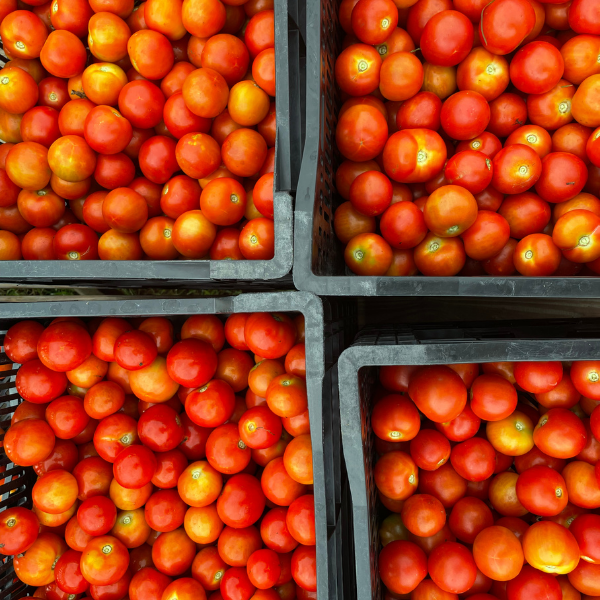
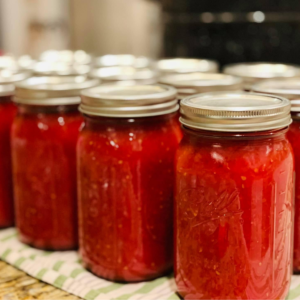 1.Can them whole.
1.Can them whole.